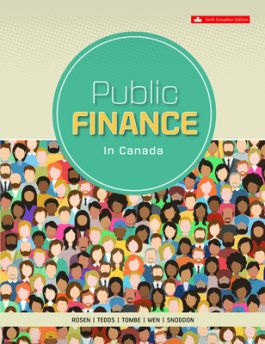Public Finance in Canada
Explore Public Finance in Canada

Application-Based Activities in Connect

Writing Assignments in Connect
CHAPTER 1: Introduction to Public Finance in Canada
CHAPTER 2: Fundamentals of Welfare Economics
CHAPTER 3: Cost-Benefit Analysis
PART TWO: A Framework for the Analysis of Public Finance
CHAPTER 4: Public Goods
CHAPTER 5: Externalities
CHAPTER 6: Income Redistribution
CHAPTER 7: Deficit Financing and Public Debt
CHAPTER 8: Fiscal Federalism
PART THREE: Public Expenditures in Canada
CHAPTER 9: Health Care
CHAPTER 10: Employment Insurance
CHAPTER 11: Public Pensions
CHAPTER 12: Provincial Income Assistance Programs
CHAPTER 13: Education PART FOUR:A Framework for Tax Analysis
CHAPTER 14: Tax Incidence
CHAPTER 15: Taxation and Efficiency
CHAPTER 16: Efficient and Equitable Taxation
PART FIVE: The Canadian Revenue System
CHAPTER 17: The Personal Income Tax
CHAPTER 18: Personal Taxation and Behaviour
CHAPTER 19: Consumption Taxation
CHAPTER 20: Taxes on Wealth and Property
CHAPTER 21: The Corporation Tax
ONLINE APPENDIX: Public Choice
GLOSSARY
REFERENCES
INDEX
There is no doubt that the SARS-CoV-2 (COVID-19) pandemic was an unprecedented health and economic shock. The pandemic not only disrupted many aspects of our daily lives but also brought on the largest peacetime increases in program spending by many governments throughout the world. This has resulted in a shift in views around the nature of public finance and the role of government. The Sixth Canadian Edition of Public Finance in Canada combines the universal frameworks of public finance with major real-world developments since March 2020, adding considerable value to students and instructors of public finance in Canada.
In the Sixth Canadian Edition of Public Finance in Canada, substantial revisions enhance the currency of the textbook, including:
- Coverage of the impact of the pandemic.
- Extensive data revisions throughout the book.
- The integration of a clearer understanding of public finance through an intersectional lens.
- The Sixth Edition matches learning objectives to both content and exercises in the chapter, making it easier for instructors who want to emphasize specific learning objectives within the chapters.
- The "In the News" callouts updated or replaced with new content based on current events.
- Names of people used in examples have also been updated to represent greater diversity in the Canadian population, and gender-inclusive language has been incorporated throughout.
New Connect Interface. Featuring significant improvements to instructor workflows in Connect, with new features designed to make course management easier:
- NEW! Add Co-Instructors to a Section. Instructors can easily add additional instructors to any section.
- Updated Section Dashboard. The redesigned section dashboard surfaces important information about student performance and assignments without additional clicks.
- NEW! Optimized for Mobile and More Accessibility. Automatic resizing of screen for tablets and smart phones. New pages are screen reader compatible, keyboard navigable, and have up to 400% magnification.
- NEW! Assignments Tab. Provides a clean interface with the ability to view important assignment information without additional clicks. Quickly view information such as assignment types, proctored assignments, and assignments that require manual grading.
Canadian Perspective. Rosen et al. provides a modern treatment of the theory of public finance, and thorough discussion of empirical issues, from a Canadian perspective.
Comprehensive Coverage. Coverage includes an integrated introduction to tax and expenditure decisions (including financing of expenditures in the chapters on health care, education, employment insurance, and public pensions), and extensive analysis of the federal-provincial dimension of the public sector in Canada.
Econometric Models. The results of econometric models are used to help the student understand how expenditure and tax policies affect individual behavior and how the government itself sets policies.
Integration of Theory and Analysis. Rosen integrates the analysis of government spending and taxing closely with economic theory. The goal is to interweave institutional, theoretical, and empirical material to provide students with a clear and coherent view of government spending and taxing.
SmartBook 2.0. Available within Connect, SmartBook 2.0 personalizes learning to individual student needs, continually adapting to pinpoint knowledge gaps and focus learning on concepts requiring additional study. For instructors, SmartBook tracks student progress and provides insights that guide teaching strategies and advanced instruction, for a more dynamic class experience.
McGraw-Hill Connect is an award-winning digital teaching and learning solution that empowers students to achieve better outcomes and enables instructors to improve course management efficiency.
High-Quality Course Material
Our trusted solutions are designed to help students actively engage in course content and develop critical higher-level thinking skills while offering you the flexibility to tailor your course to the ways you teach and the ways your students learn.
Assignments & Automatic Grading
Connect features a question bank that you can select from to create homework, practice tests and quizzes. Dramatically reduce the amount of time you spend reviewing homework and grading quizzes, freeing up your valuable time to spend on teaching.
Analytics & Reporting
Monitor progress and improve focus with Connect’s visual and actionable dashboards. Reports are available to empower both instructors and students with real-time performance analytics.
Seamless Integration
Link your Learning Management with Connect for single sign-on and gradebook synchronization, with all-in-one ease for you and your students.


